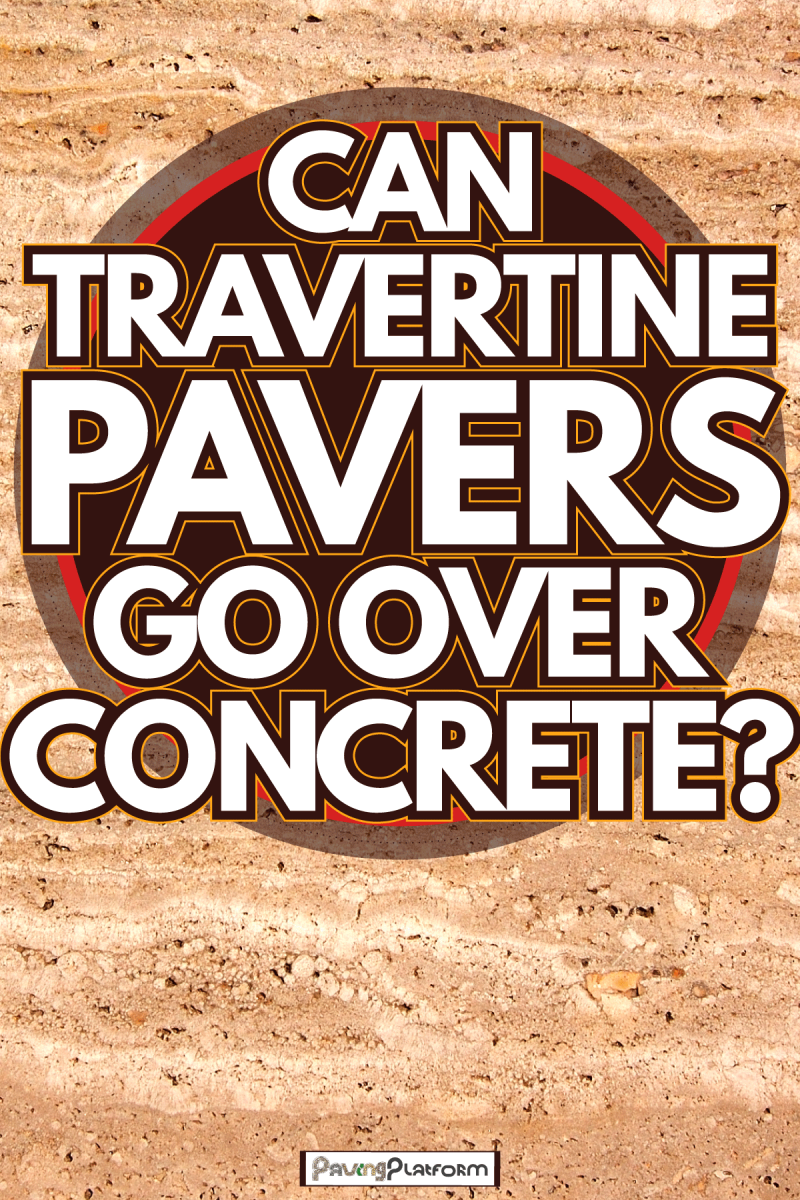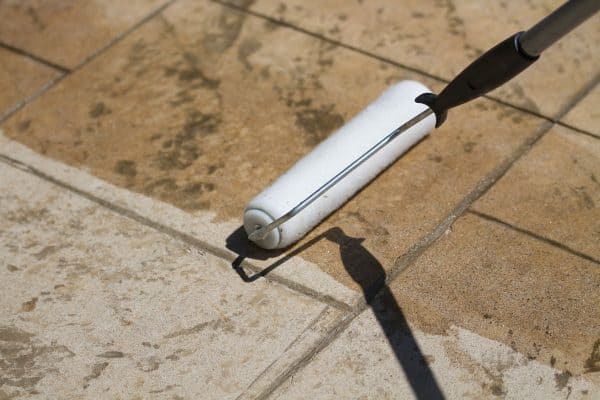Disclosure: We may get commissions for purchases made through links in this post.
So you like to spruce up your concrete but don’t want to go through the hassle of demolishing it and want to know if travertine pavers can go over concrete? We've got the answer from the experts!
Yes, you can lay travertine pavers on top of existing concrete. You just have to sand the surface first, then arrange the stones into your desired pattern and secure them with mortar or concrete adhesives.
Read further to learn certain advantages and disadvantages of installing travertine pavers over concrete. We'll also delve into the best method of doing it.

Is It A Good Idea To Install Travertine On Concrete?
Installing travertine over concrete is a common practice. A lot of homeowners do this because it's cheaper and easier than tearing up the old concrete and starting fresh. Also, it is a great way to upgrade your concrete walkway, especially as travertine is attractive and comes in a variety of colors and patterns.

Is Travertine Good For Outdoors?
Yes, travertine is an excellent option for outdoor projects; it can withstand unpredictable weather, wind, and UV rays. Thanks to their flexibility and hard-wearing nature!
Installing Travertine On Concrete

No matter how uncomplicated you think the process of laying travertine on concrete is, it has its good and downsides:
Benefits
- The material has grown in popularity because of its natural beauty and versatility, which means it can increase the value of your home.
- Removing concrete is a messy, expensive job. By installing travertine pavers on top of existing concrete rather than replacing it, you can lower the renovation costs.
- Some communities require their residents to maintain open space as part of stormwater management. Porous materials like sand, which is required to install travertine pavers, can support the program by reducing the amount of runoff and increasing the absorption rate in the ground.
Drawbacks
- If a surface is in a bad shape, the travertine will get easily damaged.
- Over time, the sand underneath the pavers will begin to shift and become loose. Some customers opt to remove the sand in favor of mortar installations, as the constant tracking of the sand inside is bothersome.
- Once concrete cracks due to constant shifting, travertine can settle and sink.
How To Install Travertine Pavers On Concrete
- Inspect if the area you wish to add paver to is properly sloped. If not, you have to create drainage to prevent the water runoff from seeping through the bedding.
- Tidy the concrete. Pressure wash the concrete to get rid of grimes and debris then allow it to dry thoroughly.
- Pour the sand and cover the concrete with it. Approximately 1.5 inches deep provides a good base for the paver.
- You can now lay the pavers down and arrange as you wish. Make sure that they fit together. Fill the gaps with sand, if necessary.
- Hold down the perimeter and secure them in place using a plastic edging or mortar. You can also use a special type of adhesive. Once done, allow it to cure and dry.
Is It Better To Tear Up Existing Concrete?

If there's nothing seriously wrong with your concrete, we suggest not to go through the trouble of tearing it out. Doing so will save you money, and pavers can easily be removed if you want to retile.
How Long Does Travertine Paver Last?

Travertine pavers last longer than other paving materials; asphalt and concrete’s life expectancy is around 50 to 80 years. But travertine’s is more than 100 years. So no need to worry about frequent replacements.
Does Travertine Need To Be Sealed?

Travertine is porous and susceptible to moisture absorption. Just like other surfaces, you will need to seal it to protect its natural beauty and against further staining. The best sealer for travertine is the siloxane-based sealer. It’s breathable and provides superior protection against moisture and extreme temperatures.
Click here to see this product on Amazon.
How To Seal Travertine Pavers
Follow these directions below:
- Clean your pavers. Get rid of debris and stains that might prevent the sealant from adhering to the substrate.
- Rinse the travertine pavers and allow them to dry.
- Spray water, after just a few seconds, apply a thin initial coating. Spread evenly on the surface with a roller. After 30 minutes, wipe off the excess sealant with a white cloth. (Colored rug or cloth can stain the sealant.)
- Apply the second coating, then allow it to dry for 24 hours.
- Check if the sealant has settled properly.
Do You Have To Grout Travertine Pavers?

Leaving a gap (grout line) between joint pavers isn’t advisable. As much as possible, install the stones adjacent to each other without spaces in between. It is, however, advisable to apply polymeric sand over the paver joints. The sand will harden and lock them in place, minimizing the chances of them chipping.
How To Maintain Travertine Pavers
- Seal The Stone - Even the toughest pavers such as travertine can break down over time. By having your pavers sealed, you can protect them from environmental elements and prevent damage.
- Choose High-Quality Sealant - Using a low-quality sealant can jeopardize your pavement; it can wear down quickly and leave your stone vulnerable to moisture and stain. You'll need to replace your stone or deal with unexpected repair if you don't opt for a premium sealant.
- Mop Weekly - Your travertine pavers require TLC too, but you don’t need to do anything special. Sweeping and mopping once a week is enough to maintain their aesthetics.
- Don’t Use Acidic Solutions - Some people are tempted to reach for harsh cleaners like bleach or vinegar once they notice discolorations stone. But these are too acidic and can loosen the aggregate. When removing stains on travertine, stick to warm water and mild cleaning products.
- Get Rid Of Petroleum Spills - Gas and oil spills can ruin your travertine paver more than you might think, particularly if it’s not sealed; they can penetrate into the pores, causing oxidation. So don’t let them linger on the stone too long.
- Keep Grout Lines Tidy - If you have grout lines, dirt can build on them, making the entire paver look like a mess. By brushing them with baking soda diluted with water on a regular basis, you can keep them grime-free.
Is Travertine Slippery When Wet?

The traction depends on the travertine type. It’s measured by the static coefficient of friction (SCOF). The recommended rating is .50 up.
- Polished travertine paver has .40 to .50 SCOF rating, making it a little sleeky.
- Honed travertine pavers are less slippery at a .40 to .60 rating.
- Tumbled and brushed travertine is the least slippery with .50 to .70 SCOF value.
How To Make Travertine Pavers Less Slippery?
You can make travertine less slippery by applying non-slip additives. This increases traction on the surface, reducing slips and falls. It’s mixed and applied with the sealant. You may also use grit tape, it gives users the confidence to navigate any slippery surface, including stairs, ladders, loading docks, and more. The tape is resistant to dirt and water.
Click here to see this product on Amazon.
In Closing

Travertine pavers can be installed over existing concrete. After sanding the concrete, you can lay and arrange the stones as desired. It does come with drawbacks that can be bothersome, so carefully weigh them in. If necessary, contact a professional to determine the best option for your pavers.
If you liked this post, you may also like the following:
Choosing Natural Stone Pavers: Bluestone Vs. Flagstone Vs. Slate



![Vibrant Red Paver Stone Path, Can You Spray Paver Sealer? [How To Apply It]](https://pavingplatform.com/wp-content/uploads/2022/04/Vibrant-Red-Paver-Stone-Path-600x400.jpg)
![Properly laid out red pavers for a garden, Can You Tint Paver Sealer? [And How To]](https://pavingplatform.com/wp-content/uploads/2022/04/Properly-laid-out-red-pavers-for-a-garden-600x400.jpg)
